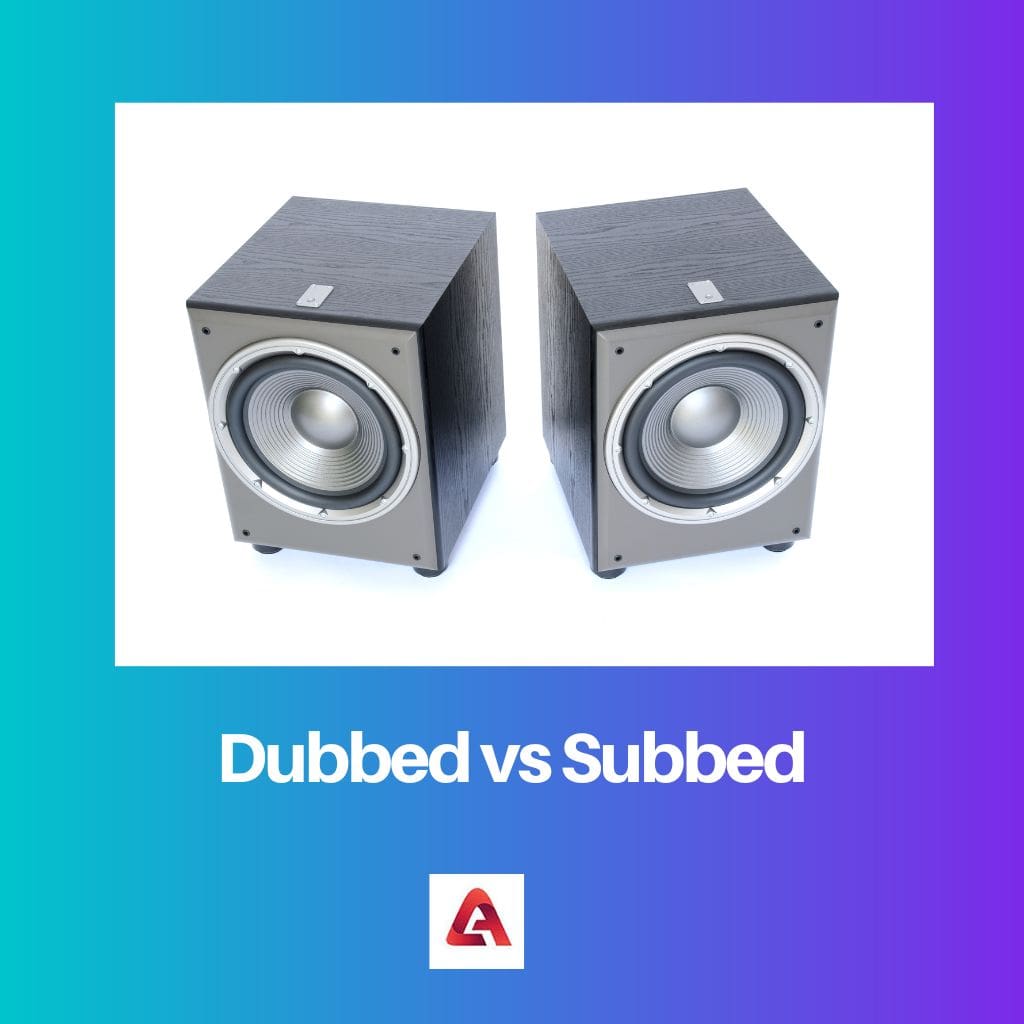There is a craze for movies, shows, anime, etc., which cannot be explained. People worldwide, no matter what age group, enjoy watching it.
Many different types and genres of movies, videos, etc., are available so that the viewers can choose and watch according to their preferences.
Earlier, people could only watch videos of a language they understood, whereas now, they have the privilege to watch any video of any language.
Technology has taken an immense leap and improves every day. This has made it possible for people to understand any video, audio, any foreign material.
Dubbed and subbed are two methods that provide translation to the local people to have a better understanding. They both have their differences, pros and cons.
Key Takeaways
- Dubbed refers to a version of a movie or TV show in which the original audio is replaced with a new language.
- Subbed refers to a version of a movie or TV show in which the original audio is retained, but subtitles are added in a different language.
- Dubbed versions can be easier to follow for viewers who do not understand the original language, while subbed versions retain the actual performances and dialogue.
Dubbed vs Subbed
Dubbed media involves replacing the original audio track with a translated version in the viewer’s language. Subbed media retains the original audio and includes subtitles at the bottom of the screen, providing a word-for-word translation of the dialogue.

Dubbed refers to the dubbing of any video. It removes the original voice track of the video and replaces it with a voice track of the adapted country (in the language needed).
It should be carefully done as it has to sync with the lip movements of the dialogues in the original video. It can also be used to add sound effects to the track according to their wishes.
The timing of the dubbed voice and the actor’s dialogue should be the same, or else it might lag, and the scene won’t match the dialogue leading to confusion.
Subbed refers to subtitles; this is a technique to add subtitles to a foreign language video. The original audio and language of the soundtrack are retained.
Subtitles are captions that appear on the screen for the viewers to read and understand the video content. The viewer has to be quick in reading the subtitles to match the timing of the scene.
No content is changed, and hence it is considered pure by all the fans.
Comparison Table
| Parameters of Comparison | Dubbed | Subbed |
|---|---|---|
| Refers to | Dubbing | Subtitles |
| Definition | Dubbed removes the original soundtrack and adds/replaces it with a new voice track. | Subbed retains the original sound and just adds subtitles as captions for the reader to read. |
| Voice Quality | The voice quality can differ due to uncertain conditions. | The voice quality remains intact. |
| Types | Lip sync, voice-over, lectoring, looping, etc | Hard-subs, soft-subs, internal, external, etc. |
| Costs | Can be expensive | Comparatively less expensive |
| Cons | The audio might lag, the meaning may change in a different language, etc. | The subtitles may not match the dialogues. The reader needs to be fast in reading the captions. |
What is Dubbed?
Dubbing is a method of providing the translation of any foreign language. It means to add or alter the sound.
Dubbing is a post-production process that adds new sounds and dialogues to the audio track according to the language that is being dubbed. The dub shots are synchronized carefully according to the lip movements of the original track.
Dubbing is also done on shots that do not have a good quality of sound to hide the mistakes in the dialogues of a video or lines of a song. To get high quality, regardless of the actual conditions that occurred during the shoot, the actors lip the dialogues or songs and then dub the sound later while editing.
Sometimes synchronized filming can be expensive for a few filmmakers, so they opt for the dubbing method for soundtracks. Synchronized audio can get disturbed for several reasons, such as air traffic, the distance of the actors from the MIC, mistakes by the actors, continuous re-takes, etc.
All these can be rectified by dubbing.
This method has several advantages, it helps the viewers to concentrate better on the content, as they are familiar with the language, and they won’t have to rewind the scene several times, to understand the dialogues in the plot or the scene. Script translation, voice casting, voice actor recording, dialogue mixing, and release are steps that are involved in dubbing.
There are different kinds of dubbing –
- Lip sync
- Voice over
- Lecturing
- Looping or ADR ( automatic dialogue replacement)

What is Subbed?
Subbed refers to subtitles; it is a technique that makes it easy for the viewers to watch any foreign language video, a video of a language they are unfamiliar with. This technique adds subtitles as captions in the videos.
It does not tamper with the original video. These captions appear on the screen, and the respective subtitles are displayed when the dialogues are delivered.
The viewers read the subtitles to understand the scene.
This is a less mainstream way of doing transactions for videos. It requires undivided attention from the viewer, or there is a high chance of them missing out on the dialogue and having to rewind to understand.
Few people prefer this method as the movie content hardly changes. It is considered to be ‘pure’ by a few fans; the essence remains intact.
This method proves to be useful for deaf people; this also allows people to watch videos anywhere without disturbing others, and subtitles are considered to be a way of learning a new language.
One should select the audio for subtitling, enter their lines, save, and encode them. You should select any platform you want to add your subtitles to and then upload the file.
You can also turn them on/off from the menu option given as and when you like.
Subtitles are easily available online; you can download them and add the file to your video. Usually, platforms like Netflix, Prime Videos, etc., give their viewers an option of 5-6 languages to choose from.
Formats – sub rip (named with the extension .srt), substation alpha (also called SSA), sub viewer (used with .sub extension), timed text (real-time captioning), micro DVD.
There are three common types of subtitles
- Hard-subs/ open subtitles
- Pre-rendered
- Soft-subs/ closed subtitles
Another category of subtitles is –
- Internal (single video file container)
- External (broadcasted as separate files)

Main Differences Between Dubbed and Subbed
- Dubbed refers to the dubbing method, whereas subbed refers to subtitles.
- Dubbed removes the original soundtrack and adds/replaces it with a new voice track, whereas subbed retains the original sound and adds subtitles as captions in the video.
- The dubbed method is comparatively a little expensive, whereas subbed is not so expensive.
- Lip sync, voice-over, lecturing, and looping are types of dubbing, whereas hard-subs, soft-subs, internal, and external are types of subtitles.
- In dubbed audios, sometimes the voice quality may be affected due to uncertain conditions, whereas the quality remains intact in subbed.

- https://link.springer.com/chapter/10.1057/9780230234581_7
- https://books.google.co.in/books?hl=en&lr=&id=MlW4AwAAQBAJ&oi=fnd&pg=PP1&dq=subtitling&ots=Aoy_9ziUP4&sig=JfpPW-T_hhLYKvLs2oDiQvoEmyM

I never realized the extensive process that goes into dubbing and subtitling foreign language media, it’s quite intriguing.
The advancements in technology have allowed us to enjoy videos and movies in different languages more easily than ever before.
I agree, dubbing and subtitling have made foreign language media more accessible to a larger audience.
The article provides valuable information on the intricacies of dubbing and subtitling, shedding light on the complexities involved in making foreign language media accessible to all audiences.
Certainly, it’s interesting to understand the efforts behind translating foreign language media, which we take for granted.
The process of dubbing and subtitling is more complex than I had realized, especially in terms of synchronizing voice tracks and subtitles with the original content.
Agreed, the technical aspects of dubbing and subbing are quite fascinating to learn about.
Understanding the process of dubbing and subbing helps appreciate the effort that goes into making foreign language media accessible to all audiences.
The article does a great job in explaining how dubbing and subtitling work, and the challenges associated with each method.
I wasn’t aware of the intricacies involved in dubbing and subtitling, but now I have a better understanding of it.
The dubbing and subbing processes have their own advantages and disadvantages as mentioned in the article.
I believe the comparison table provides a clear overview of the differences between dubbed and subbed media.
The article provides a comprehensive overview of the differences between dubbed and subbed media, which is quite informative.
The challenges associated with dubbing and subbing, as well as the technical details involved in these processes, are well-explained in the article.
The article provides valuable insight into the world of dubbing and subtitling, especially for those unfamiliar with the processes.
The complexities of dubbing and subtitling are fascinating, and the article does a great job in breaking down the differences and challenges of each method.
The benefits and drawbacks of both dubbed and subbed media are clearly outlined in the article, making it easier to understand the complexities of translation in media.
It’s interesting to learn about the different methods of translating foreign language media for viewers.
Yes, the comparison between dubbed and subbed is quite helpful to understand the differences between the two.